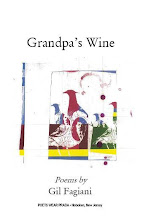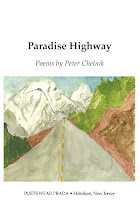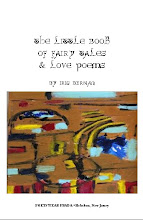Reprinted from Entropy, May 31, 2016
The Beautiful Moment of Being Lost by Michael T. Young
 |
The Beautiful Moment of Being Lost by Michael T. Young
Poets Wear Prada Press, 2014
88 pages – PWP / Amazon |
by Therése Halscheid
Titles lure us to books. They serve as a grounding cord, to situate
us in a particular location or overarching theme. They establish a
mindset to navigate content. This is what happened to me while reading
Michael T. Young’s collection:
The Beautiful Moment of Being Lost.
In Young’s title, the abstract noun
lost is concretized in
poems that depict the poet as a wanderer in both familiar and foreign
locations. The poem “A Method of Escape” exemplifies this:
Whenever we go for a walk you ask
where we are going and I think,
Eventually, where we started.
Young then encourages us to step off the cyclical path. He invites us
to get lost during walks in a familiar place. For the poet, spontaneity
reveals unexpected treasures. “Never let the usual expectations plot
the course,” he writes.
… let the time between be unplanned,
as uncharted as the charted urban streets we allow….
In other poems
lost represents a psychological state as in
lost in thought, the meandering mind. Or lost in the sense of questioning who we are.
Lost turns to
loss
when it captures the powerlessness one feels when confronted with
illness and the death of a loved one, or events over which we have no
control.
And there are other meanings, unusual interpretations for
lost,
such as becoming lost through language, through something as miniscule
as a six-letter word. In the poem “The Word ‘Anyway’” the poet examines
how “anyway” works as a detour, which sets him off course: “like a ramp
off the highway leading me somewhere else,” which inevitably takes him
“in another direction, though not, / necessarily, in a better one….”
The second abstract word in Young’s title is
beautiful. For me, the word is representative of the poet’s consciousness. It is not the journey itself, but
the way
he sets off through uncharted terrain that is reflective of an
enlightened mind. For the poet, lost paths are meaningful if we remain
open to what they present. In this sense
lost is what happens, but
beauty is the approach. This is this writer’s path, when exploring themes of life and death, physical and mental landscapes.
Young is a lyric poet. He is adept at image making. The “oak’s bare
branches lurch / into the winter air” while “puddles release their
smallest / reflections.” Certain images act as a gong. They reverberate
long after our eyes move on, to another page, as in these lines of
“Random Note”:
… where I sit on the bench, shade slips over me like a hood,
and I’m whisked off, abducted by the day’s closing minions….
What I also admire about this collection is cadence. Many poems share
a rhythm of ease that leads us from one moment to the next. It is
obvious that Young is a careful crafter. Poems are mapped out using
intentional line breaks — end-stopped or enjambed. And this creates a
steady walk through words. Even the overall tone does not carry the
voice of someone frantic and lost. Instead the poet winds his way
through endless territory, skillfully as his use of enjambment. He
speaks of this in “The Continuous Thread” when he writes: “One thing
leads endlessly to another. / Even if this street is a dead end, / it
will continue in a different fashion…”
Young’s book holds to this premise: where one is led to, one is led
to observe. In his signature poem “The Beautiful Moment of Being Lost,”
he addresses this: “The secrets of a place are in its small streets, /
its narrow passages…” (49). Traveling like this, even that which we tend
to avoid can seem profound. As in the poem “Slug”:
Watching his deliberate movement, I forgot
he was a name we give each other in contempt.
What I noticed was his strange beauty and slow power,
and what in me refuses to be rushed….
Moving purposely, willfully, the poet remains a lifelong voyager but
without a definite map. What he encounters he accepts. In “As Is” the
poet shares “even before I recognize these things / for what they are,
/everything is / as it should be.”
In “Eyewitness,” while crossing the Hudson River on a ferryboat, he ponders:
… I would like to think, in spite of it,
that my inner vision is sharper
as if age alone could teach me the apostle’s words
to ‘walk by faith, not by sight.’
This is what Young aspires to. Faith is required to journey in ways
that are foreign. Faith helps us move through the unfamiliar — that we
might come out of it, changed. In his poem “Directions” the poet relies
on this belief:
Our heads tilt in a slow nod or shake;
our eyes cross figures in the air
writing a tenuous language that seems to say
there is no backward or forward,
no behind or ahead, only movement
from character to character, from stop to stop,
in books, on trains, in memory….
This is the message that Young leaves us with. The poet is first
lured into the world “thrilled by the risk and uncertainty.” He then
gathers strength, as he says, “from the pleasure / of wondering if I
would make it home.”
 Therése Halscheid
Therése Halscheid’s latest book
Frozen Latitudes (
Press 53), won the Eric Hoffer Book Award, Honorable Mention for Poetry. Other collections include
Uncommon Geography,Without Home and a
Greatest Hits chapbook award. Poems and essays have appeared in
The Gettysburg Review, Tampa Review, Sou’wester, Natural Bridge, among others. Recent awards include first in
Welcome Table Press’s Creative Nonfiction contest. By
way
of house-sitting she has been writing on the road for several years.
Her photography chronicles her journey, and has been in juried
shows. Poems in
Frozen Latitudes recount her time in the Arctic north where she lived with and taught the Inupiaq of Alaska. See
www.ThereseHalscheid.com.





 Therése Halscheid’s latest book Frozen Latitudes (Press 53), won the Eric Hoffer Book Award, Honorable Mention for Poetry. Other collections include Uncommon Geography,Without Home and a Greatest Hits chapbook award. Poems and essays have appeared in The Gettysburg Review, Tampa Review, Sou’wester, Natural Bridge, among others. Recent awards include first in Welcome Table Press’s Creative Nonfiction contest. By way
of house-sitting she has been writing on the road for several years.
Her photography chronicles her journey, and has been in juried
shows. Poems in Frozen Latitudes recount her time in the Arctic north where she lived with and taught the Inupiaq of Alaska. See
Therése Halscheid’s latest book Frozen Latitudes (Press 53), won the Eric Hoffer Book Award, Honorable Mention for Poetry. Other collections include Uncommon Geography,Without Home and a Greatest Hits chapbook award. Poems and essays have appeared in The Gettysburg Review, Tampa Review, Sou’wester, Natural Bridge, among others. Recent awards include first in Welcome Table Press’s Creative Nonfiction contest. By way
of house-sitting she has been writing on the road for several years.
Her photography chronicles her journey, and has been in juried
shows. Poems in Frozen Latitudes recount her time in the Arctic north where she lived with and taught the Inupiaq of Alaska. See 


 Mark Fogarty’s
poetry has been published in Hawaii Review, Viet Nam
Generation, Journal of NJ Poets, Exit 13, Unrorean, Eclectic Literary
Forum, Cokefishing in Alpha Beat Soup, Footwork, The Brownstone Poets
Anthology, The TEA Newsletter, Gallery and The Rutherford Red
Wheelbarrow. Mark, also a musician, is the author of three poetry
collections from White Chickens Press, Myshkin’s Blues, Peninsula and
Phantom Engineer.
Mark Fogarty’s
poetry has been published in Hawaii Review, Viet Nam
Generation, Journal of NJ Poets, Exit 13, Unrorean, Eclectic Literary
Forum, Cokefishing in Alpha Beat Soup, Footwork, The Brownstone Poets
Anthology, The TEA Newsletter, Gallery and The Rutherford Red
Wheelbarrow. Mark, also a musician, is the author of three poetry
collections from White Chickens Press, Myshkin’s Blues, Peninsula and
Phantom Engineer.

































































